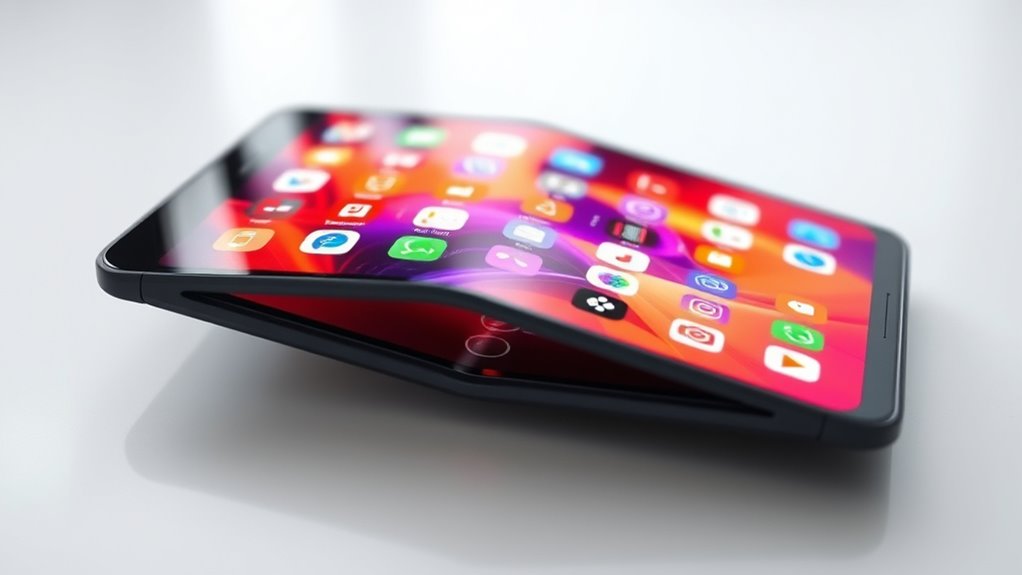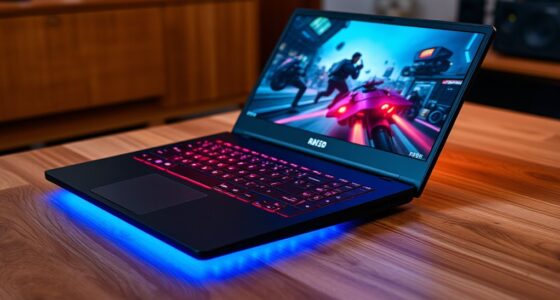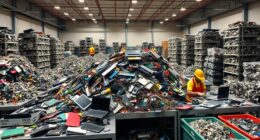Foldable screens are gaining popularity, but their future depends on durability. While the technology offers exciting features like multitasking and flexible design, concerns about wear and tear remain. Early models faced issues with creases and mechanical failures, making many cautious. Manufacturers are working to improve materials and hinge designs to boost lifespan. If you want to understand whether foldables are here to stay or just a passing fad, there’s more to discover below.
Key Takeaways
- Foldable screens are gaining popularity due to their innovative design and multitasking capabilities, signaling a technological shift.
- Durability concerns, like screen wear and mechanical failures, challenge long-term user confidence in foldable devices.
- Industry efforts focus on improving materials, hinges, and coatings to enhance foldable screen longevity and reliability.
- Consumer adoption depends on addressing durability issues and demonstrating that foldables can withstand daily use over time.
- The future of foldable screens as a mainstream technology hinges on resolving durability challenges and ongoing material advancements.

Foldable screens have quickly become a buzzword in the tech world, sparking debates about whether they represent the future of devices or just a passing trend. As a consumer, you might find yourself intrigued by these innovative devices, but also cautious about their longevity. Durability concerns are at the forefront of many discussions, especially since foldable screens are more complex than traditional displays. The flexible nature of these screens means they undergo repeated bending, which can lead to wear and tear over time. Manufacturers have made strides in improving build quality, but some early models still suffered from issues like screen creases, scratches, or even mechanical failures. These problems make you wonder: will foldable devices stand the test of time, or are they more of a fragile fad?
Your decision to adopt foldable tech hinges largely on how durable these devices prove to be in everyday use. If a device’s screen begins to degrade after just a few months, it’s unlikely you’ll see widespread consumer adoption. People want gadgets that last, not ones that need replacing or repair after a short period. While many brands now promote their foldables as robust and resilient, early adopters have reported mixed experiences, which feeds into skeptics’ doubts. As a potential user, you might hesitate to invest in a foldable device if you’re concerned about its ability to withstand your daily routines, accidental drops, or even just repeated folding. The industry’s challenge is to demonstrate that these screens can endure real-world conditions without sacrificing the flexibility that makes them appealing.
Despite these durability worries, consumer interest continues to grow. Technology enthusiasts and early adopters are drawn to the novelty, the promise of larger screens in a compact form, and the potential for multitasking. Manufacturers are racing to improve foldable designs, incorporating stronger materials, better hinge mechanisms, and protective coatings. As a result, consumer adoption is gradually increasing, especially among tech-savvy users enthusiastic to explore the latest innovations. However, widespread acceptance will likely depend on how quickly and effectively manufacturers can address durability concerns. If these issues are resolved convincingly, you may see foldable screens becoming a common feature rather than a niche product. Until then, the fate of foldables hangs in the balance—either as a true step forward in device design or a fleeting trend that fades as durability issues persist. Notably, ongoing advancements in material science are crucial for enhancing the longevity and robustness of these flexible displays.
Frequently Asked Questions
How Durable Are Foldable Screens Over Extended Use?
When considering foldable screens, you might wonder about their screen durability over time. While advancements have improved fold resilience, some screens can still develop creases or wear with extended use. You should handle your device carefully, avoid excessive folding, and keep the hinge area clean. Overall, modern foldable screens are becoming more durable, but their long-term resilience depends on careful use and ongoing technological improvements.
What Are the Environmental Impacts of Foldable Device Manufacturing?
Imagine a world where your foldable device’s eco footprint balances between innovation and waste. As you consider manufacturing impacts, you see recycling challenges that hinder sustainability, with complex materials making disposal tough. While foldable screens promote versatility, their production raises environmental concerns. You can help by supporting initiatives that improve recycling techniques and demand eco-friendly materials, ensuring tech’s future is both cutting-edge and environmentally responsible.
Are Foldable Screens More Expensive to Repair?
You might notice that foldable screens tend to have higher repair costs, which can raise affordability concerns. When your device’s flexible display gets damaged, fixing it often involves specialized parts and labor, making repairs more expensive than traditional screens. This cost factor could influence your decision to buy or keep a foldable device, especially if you’re worried about long-term affordability and maintenance.
How Do Foldable Screens Perform in Extreme Weather Conditions?
Imagine your foldable screen facing the elements—rain, heat, cold—challenging its material resilience and temperature tolerance. In extreme weather, you might notice reduced performance, possible screen flickering, or even damage if materials aren’t designed for such conditions. While some foldable screens are built with tougher materials, you should always consider their limits, as extreme temperatures can compromise flexibility and durability, impacting your user experience.
Will Foldable Technology Become Mainstream in the Next Five Years?
You might wonder if foldable technology will become mainstream in the next five years. While market adoption is steadily increasing, manufacturing challenges like durability and cost still pose hurdles. If companies address these issues effectively, you’ll likely see foldables integrated into daily life more widely. However, slow progress in overcoming production obstacles could delay their widespread adoption, making it uncertain whether foldable tech will truly go mainstream soon.
Conclusion
As you watch foldable screens unfold their potential, it’s like witnessing a new chapter in tech history. While they might seem like just a passing fad now, their innovation could reshape how you interact with devices, making flexibility the new normal. Stay curious and open-minded, because what’s unfolding today might just become your everyday essential tomorrow. Like a butterfly emerging from its cocoon, foldable screens could transform your tech experience in ways you never imagined.









